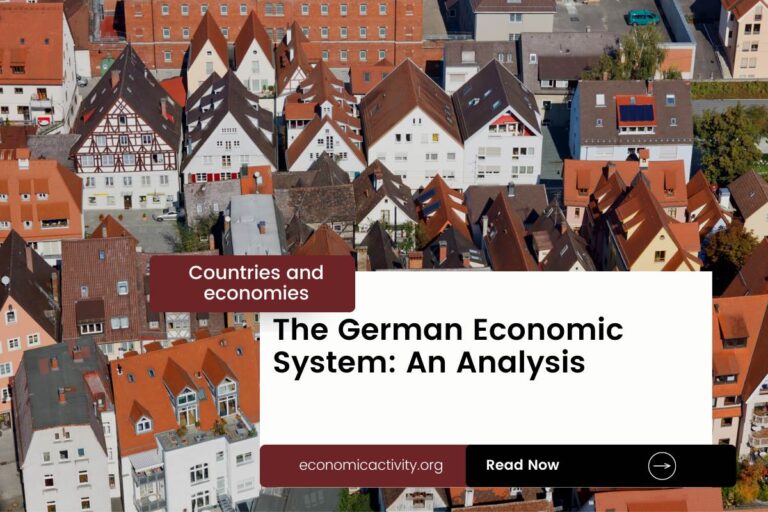Germany, with a population of 83,797,985, is ranked 18th globally, just behind Turkiye. Located in Europe, it covers 357,590 sq. km, ranking 62nd, just behind Japan.
Germany, with a GDP of $4,082,469,490,797.68 in 2022, holds the 4th position globally, trailing behind Japan with a GDP of $4,256,410,760,723.75. The country’s GDP per capita stands at $48,717.99, ranking 24th worldwide, falling short of Hong Kong SAR, China with a GDP per capita of $48,983.62.
Germany’s economic position is strong, with a diverse economy driven by manufacturing, technology, and exports, making it a key player in the global market.
What are the economic activities of Germany?
- Primary activities: 0.7% of GDP.
- Secondary activities: 30.7% of GDP.
- Tertiary activities: 68.6% of GDP.

Primary Sector of Germany
The primary sector in Germany, particularly its agricultural activities, thrives due to its temperate climate and rich natural resources. Approximately 47.49% of the country’s land is dedicated to agriculture. The main agricultural products include milk, sugar beets, wheat, barley, potatoes, pork, rapeseed, maize, rye, and triticale.
Despite contributing only 0.7% to the GDP, agriculture plays a crucial role in the economy. The diverse range of crops and animal products highlights the sector’s significance, providing employment and sustaining rural communities.
With its rich geological diversity, the primary sector benefits from abundant natural resources like coal, lignite, iron ore, and natural gas. These resources drive the economy through industries such as mining, energy production, and construction. Additionally, the availability of arable land supports agriculture, while timber and salt extraction industries further contribute to the sector’s growth.
Germany’s oil production, ranking 39th globally, yields approximately 35,664 barrels per day from reserves of 132,480,000 barrels, representing 0.01% of global reserves.
Germany’s natural gas production in 2020 reached 8,730 million m³, ranking 45th globally. This production significantly contributes to the country’s gas economic activity, supporting industries such as energy production and construction.
Secondary Sector of Germany
What is the secondary sector or what are secondary activities?
The secondary sector involves industries that transform raw materials from primary activities into finished products for consumption. Germany, a leading industrial nation, produces a wide range of products including iron, steel, coal, cement, chemicals, machinery, vehicles, electronics, automobiles, and textiles, among others.
Manufactures play a crucial role in Germany’s total exports, accounting for 84.39% in 2023. This highlights the significance of the manufacturing sector in driving the country’s export economy.
Tertiary sector of Germany
What is the tertiary sector or what are tertiary activities?
The tertiary sector in Germany encompasses services that offer knowledge, time, and intangible goods to enhance productivity and meet needs. Key activities include healthcare, education, banking, communication, media production, tourism, and transportation. These sectors play a vital role in the country’s economy and contribute significantly to its overall growth and development.
Specifically, Germany’s tourism industry, with an annual arrival of 39,563,000 tourists and a ratio of 0.4721 arrivals per capita, plays a relatively minor role in the country’s overall economy. Despite its rich cultural heritage and scenic landscapes, the tourism sector contributes modestly to Germany’s robust and diversified economic landscape, which is primarily driven by manufacturing, technology, and exports.
Another example of tertiary economic activity is the mobile cellular sector, boasting over 104 million subscriptions, which fosters technological growth by enhancing connectivity, driving innovation, and supporting digital services.
Military Activities and Economic Sectors of Germany
The military is a clear example of many economic activities working together. In the primary sector, resources are extracted for military use, like metals for weapons. The secondary sector involves the manufacturing of military equipment, such as tanks and aircraft. The military also provides services in the tertiary sector, while the quaternary sector focuses on research and development for new technologies. Finally, the quinary sector includes high-level decision-making and strategy.
In Germany, the military expenditure for 2023 is about $66.83 billion. This spending is 1.39% of the country’s GDP. Germany has an active military force of 183,500 personnel, which means there are 2.9 active military members for every 1,000 people in the country.
Biggest company in Germany
Which is the biggest company in Germany? The largest company is SAP, a leader in IT software and services. Founded in 1972, SAP has a market value of approximately $124.02 billion. It plays a crucial role in the tertiary sector, providing software solutions to businesses worldwide.
International Trade of Germany
Import Activities of Germany

Germany’s high import activities, accounting for nearly 49% of its GDP, are crucial for its economy’s growth and stability.
Germany’s import activities are diverse, with key partners including China, Netherlands, Poland, Belgium, and Italy. The country mainly imports natural gas, cars, garments, vehicle parts/accessories, and crude petroleum.
Exports Activities of Germany

Germany’s export activities are of high importance, constituting over 50% of its GDP in 2023. Total exports reached $1.7 trillion, reflecting a strong global economic presence.
Germany’s export activities are diverse, with major partners including the US, France, China, Netherlands, and Italy. Key export commodities are cars, medicine, vehicle parts, vaccines, and plastic products.
Germany economy challenges in 2024
Germany, a leading diversified economy in the EU, faces challenges in 2024. Growth is stalled by an energy crisis, and a tight labor market is compounded by a falling working-age population. Fiscal rebalancing is underway with the phaseout of energy price supports, impacting key industries like automotive and green energy.




Leave a Reply